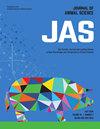Predicting dry matter intake in cattle at scale using gradient boosting regression techniques and Gaussian process boosting regression with SHAP explainable AI, MLflow and its containerization
IF 2.7
2区 农林科学
Q1 AGRICULTURE, DAIRY & ANIMAL SCIENCE
引用次数: 0
Abstract
Dry matter intake (DMI) is a measure critical to managing and evaluating livestock. Methods exist for quantifying individual DMI in dry lot settings that employ expensive intake systems. No methods exist to accurately measure individual DMI of grazing cattle. Accurate prediction of DMI using machine learning (ML) promotes improved production and management efficiency. It also opens the door to empowering producers to validate and verify intakes in order to participate in incentive programs for delivering ecosystem service credits. We explored gradient boosting-based approaches to predict DMI in beef cattle using actual animal intake and climate dataset of 12,056 daily records from 178 cattle fed at West Virginia University from 2019 to 2020. The tested and developed methods include gradient boosting regression (GBR), Light boosting regression (LGB), extreme gradient boosting regression (XGB), and Gaussian process boosting (GPBoost) models and two baseline models: 1. Nutrient Requirements of Beef Cattle (NASEM 2016) Equation & 2. Mixed Linear Model Regression (MLM). The GPBoost models were developed considering the random effects associated with animal ID and date. Moreover, we developed an end-to-end MLoperations (MLOps) pipeline to streamline the ML steps using crucial components, such as MLflow and Dockerization. The best performing model was determined by comparing the common evaluation metrics such as root mean squared error (RMSE), mean squared error (MSE), mean absolute error (MAE) and mean absolute percentage error (MAPE). The RMSE values on the test data of the optimized models ranged from 1.18 kg to 1.54 kg. The focus was developing a generalized algorithm that models covariates associated with animal ID and date that would generalize well on unseen data. The GPBoost models exhibited the best bias and variance compared to the other models (MLM, GBR, LGB, XGB). The R2 of the GPBoost on the training and test datasets were 0.58 and 0.55 respectively. The GPBoost model generalized well on the test dataset and train dataset with MAE values of 0.92 kg and 0.90 kg respectively We implemented an end-to-end MLOps pipeline with MLflow and Docker, enabling experiment tracking, model registry, reproducibility and scalability (to deploy on multiple computers) and seamless deployment. This approach offers a reliable and scalable solution for accurate DMI prediction, enhancing livestock management and facilitating participation in ecosystem service credits.求助全文
约1分钟内获得全文
求助全文
来源期刊

Journal of animal science
农林科学-奶制品与动物科学
CiteScore
4.80
自引率
12.10%
发文量
1589
审稿时长
3 months
期刊介绍:
The Journal of Animal Science (JAS) is the premier journal for animal science and serves as the leading source of new knowledge and perspective in this area. JAS publishes more than 500 fully reviewed research articles, invited reviews, technical notes, and letters to the editor each year.
Articles published in JAS encompass a broad range of research topics in animal production and fundamental aspects of genetics, nutrition, physiology, and preparation and utilization of animal products. Articles typically report research with beef cattle, companion animals, goats, horses, pigs, and sheep; however, studies involving other farm animals, aquatic and wildlife species, and laboratory animal species that address fundamental questions related to livestock and companion animal biology will be considered for publication.
 求助内容:
求助内容: 应助结果提醒方式:
应助结果提醒方式:


